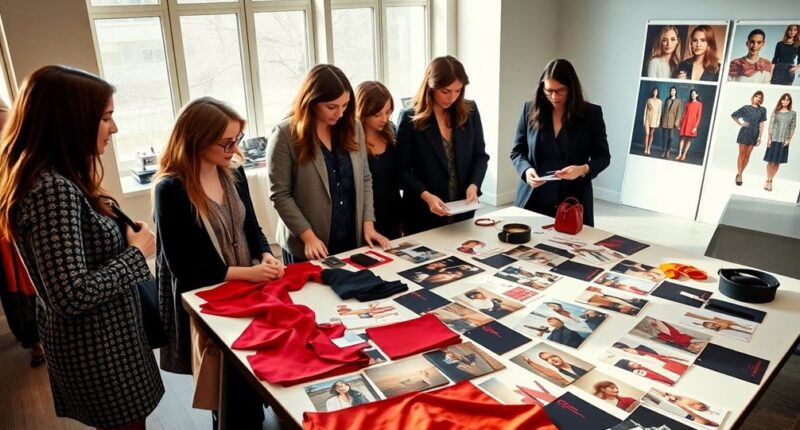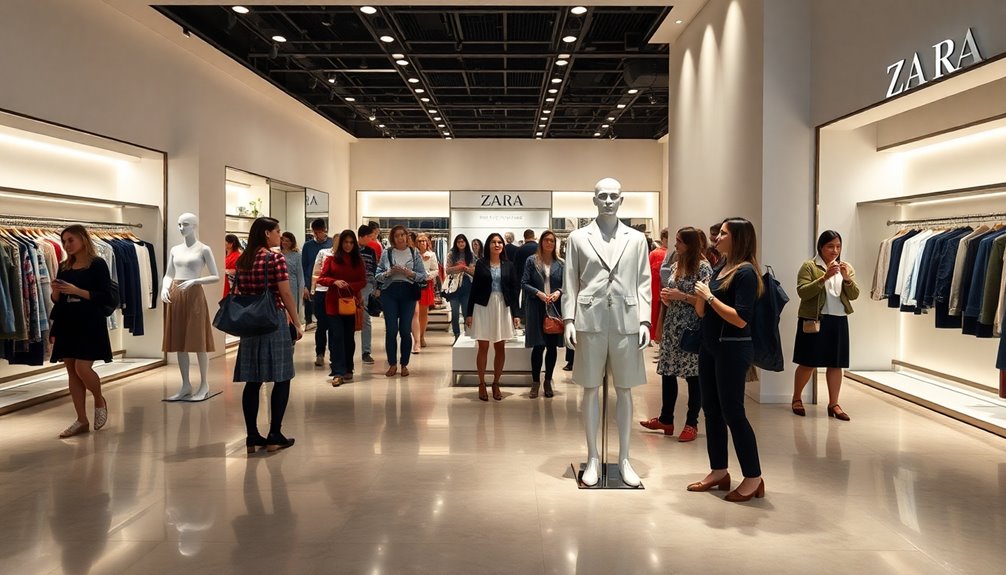Fashion buyers play an essential role in shaping retail by selecting trends and products that connect with consumers. They analyze market data, monitor social media, and attend trade shows to stay ahead. By fostering strong relationships with suppliers, they secure quality products and negotiate prices. Effective inventory management guarantees they meet consumer demand without overstocking. This behind-the-scenes process isn't just systematic; it requires intuition and adaptability. Discover how their decisions truly impact your shopping experience.
Key Takeaways
- Fashion buyers utilize trend forecasting tools and social media analysis to identify emerging styles and consumer preferences.
- They analyze past sales data and engage in trade shows to gain insights into market trends and buying patterns.
- Strong relationships with suppliers allow buyers to negotiate quality products and better prices while ensuring timely deliveries.
- Continuous inventory management and data analysis help buyers align product selections with customer demands and seasonal trends.
- Behind-the-scenes content enhances brand storytelling and consumer trust, showcasing the thoughtful process of trend and product selection.
The Role of Fashion Buyers in Retail
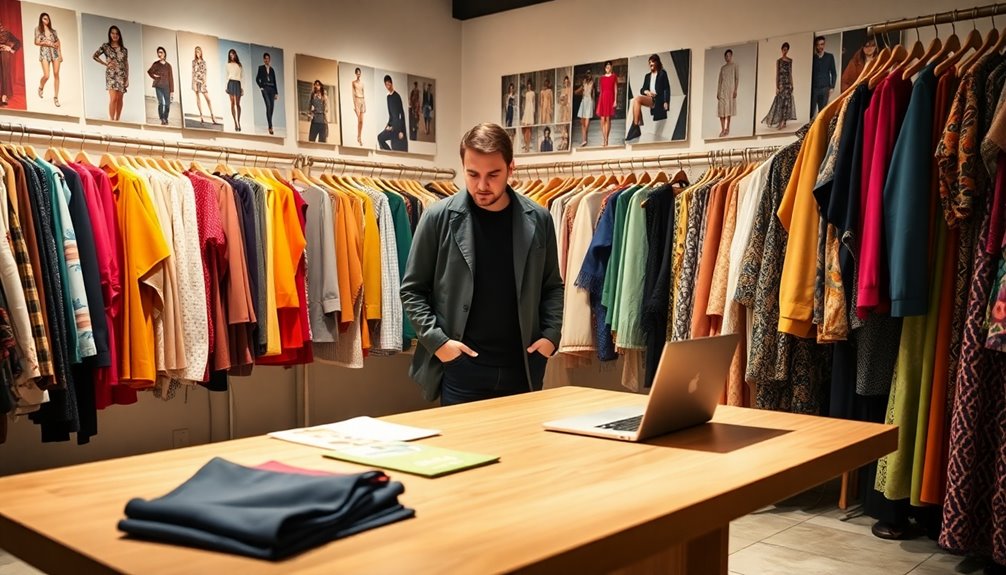
Fashion buyers play an essential role in retail, as they're the ones who decide what merchandise will hit the shelves. You'll find yourself deeply engaged in trend forecasting, analyzing current styles, colors, and fabrics to predict what customers will want in the future.
By studying market analysis and customer buying patterns, you maximize profits while ensuring the collection aligns with your brand identity. Building strong relationships with suppliers is vital for effective negotiation and securing timely deliveries of high-quality products.
You also spend hours in showrooms and reviewing sales data, all while working within budget constraints and developing competitive pricing strategies. Ultimately, your keen insights and decisions shape the shopping experience for countless customers.
Analyzing Market Trends and Consumer Preferences

When you analyze market trends and consumer preferences, you're tapping into essential fashion forecasting tools and monitoring social media trends.
These resources help you understand what styles resonate with customers and what's gaining traction online.
Utilizing Fashion Forecasting Tools
To stay competitive in the ever-evolving apparel industry, buyers need to harness various fashion forecasting tools that analyze market trends and consumer preferences.
By utilizing social media analytics and trend forecasting services, fashion buyers can effectively assess which design elements—like silhouettes, colors, and fabrics—are likely to resonate with customers.
Continuous research is essential, allowing you to adapt your product selections to shifting consumer demands. Comparing current trends with past sales data helps predict future buying patterns, enhancing your decision-making process.
Additionally, engaging with trade shows and fashion events provides firsthand insights into emerging trends and strengthens relationships with suppliers. Furthermore, incorporating data analytics into the buying process can lead to more informed decisions that align with consumer behavior.
Monitoring Social Media Trends
Social media platforms have become essential for fashion buyers looking to stay ahead of trends. By monitoring social media, you can tap into real-time consumer engagement and preferences.
Here's how you can leverage these tools effectively:
- Follow fashion influencers and brands to spot emerging trends.
- Use analytics tools to track relevant hashtags and keywords.
- Analyze engagement metrics on platforms like Instagram and TikTok for predictions on bestsellers.
- Review user-generated content for consumer feedback and sentiment.
Staying on top of the latest trends through social media not only informs your selections but also enhances your purchasing decisions, ensuring you cater to what your audience truly desires. Additionally, leveraging AI-driven insights can provide deeper understanding of consumer behavior and preferences.
Embrace these strategies to refine your trend identification process.
Collaborating With Suppliers for Quality Products
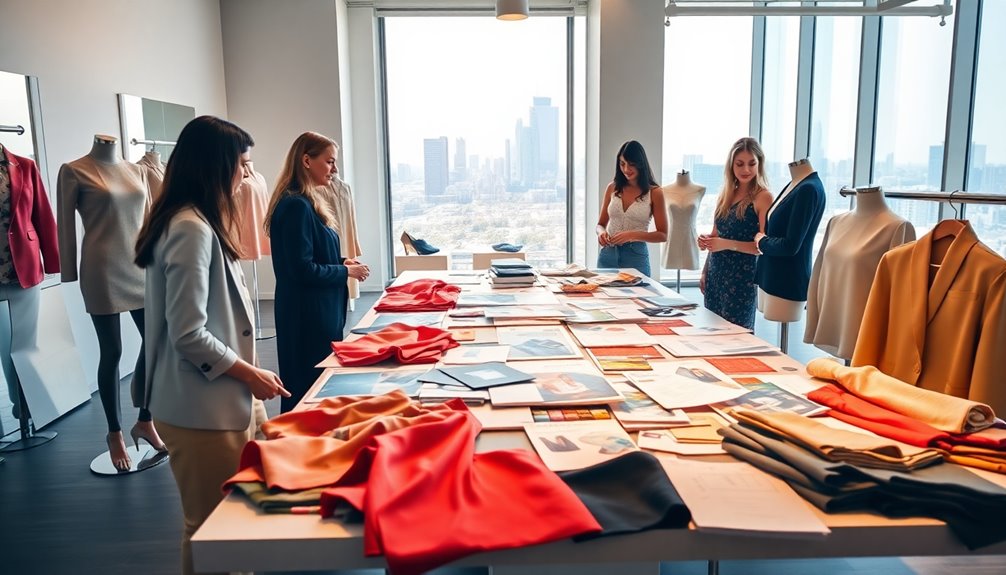
To succeed in the fashion industry, you need to build strong relationships with your suppliers.
By mastering negotiation strategies, you can secure favorable terms while ensuring quality control and assurance.
This collaboration not only enhances your product offerings but also keeps you competitive in a fast-paced market.
Building Strong Relationships
Building strong relationships with suppliers is essential for fashion buyers aiming for quality products and successful collections. When you foster these connections, you can reveal a range of benefits that enhance your purchasing process:
- Negotiate better prices and minimum order quantities
- Guarantee timely delivery and consistent product quality
- Navigate global supply chains with ease
- Stay updated on new trends and innovations in fabrics
Effective communication is key; it builds trust and reliability.
Regularly evaluating product quality and sustainability keeps you aligned with consumer expectations and ethical standards.
Negotiation Strategies and Techniques
Strong supplier relationships set the stage for effective negotiations, enabling fashion buyers to secure quality products at favorable prices. By understanding supplier capabilities and market trends, you can negotiate terms that benefit both parties. Here are some key negotiation strategies to reflect upon:
| Strategy | Description |
|---|---|
| Build Trust | Maintain open communication with suppliers. |
| Use Data | Leverage past sales data to support requests. |
| Stay Flexible | Adapt your demands for win-win outcomes. |
| Understand Market Trends | Stay informed about current market conditions. |
| Prepare Thoroughly | Gather detailed analysis before discussions. |
These approaches guarantee you not only achieve favorable pricing but also foster long-term partnerships for quality products. Additionally, understanding regulatory changes can help mitigate risks during negotiations.
Quality Control and Assurance
While collaborating with suppliers, fashion buyers must prioritize quality control and confirmation to guarantee products meet the desired standards.
This commitment involves regular communication and meticulous attention to detail.
Here are key aspects to focus on:
- Conduct firsthand evaluations during showroom visits.
- Review sample products before placing large orders.
- Discuss fabric sourcing and garment construction thoroughly.
- Ascertain suppliers adhere to ethical and sustainable practices.
Additionally, it is essential to understand state tax rates to ensure that any imported materials comply with local regulations and financial implications.
Trend Forecasting and Selection Process

Understanding the intricacies of trend forecasting and the selection process is essential for fashion buyers who want to stay ahead in a competitive market. You analyze market trends, customer buying patterns, and design elements like silhouettes, colors, and fabrics.
By utilizing tools such as social media, trade shows, and fashion forecasting services, you identify garments expected to be in high demand. The selection process involves comparing current trends with past sales data, ensuring your choices align with your boutique's brand and customer preferences.
Balancing trendy items with timeless staples caters to diverse customer needs while maximizing profitability. Continuous research and analysis are vital, allowing you to make informed decisions that enhance your overall merchandising strategy and effectively meet market demands.
Inventory Management and Order Placement
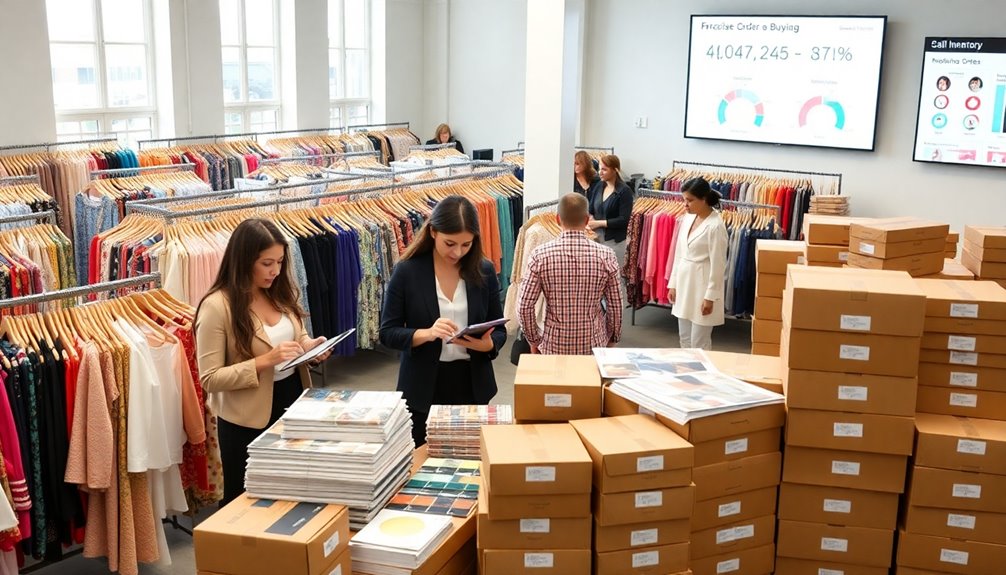
Effective inventory management and timely order placement are essential for fashion buyers aiming to optimize sales and maintain customer satisfaction. By staying organized and making informed decisions, you can prevent costly issues like overstocking or stockouts.
Here are key strategies to take into account:
- Finalize orders with vendors, double-checking details like prices and delivery timelines
- Update inventory systems to reflect new orders for accurate stock tracking
- Analyze previous seasons' sales data to align inventory with customer preferences
- Plan delivery and stocking schedules meticulously for peak shopping periods
These strategies guarantee your inventory management process runs smoothly, allowing you to meet market demand and enhance the overall shopping experience for your customers.
The Impact of Behind-the-Scenes Content

Behind-the-scenes (BTS) content offers a unique glimpse into the intricate world of fashion buying, revealing the hard work and creativity that go into selecting trends for retail.
This behind-the-scenes look not only showcases the meticulous trend forecasting but also highlights the challenges buyers face during the product selection process.
Major brands like Gucci and Dior effectively use BTS content to humanize their brands, driving engagement on social media through authentic insights into the fashion industry.
By documenting key moments in the buying journey, BTS content enhances brand storytelling and informs potential customers about the brand's values.
Ultimately, this transparency fosters consumer trust and loyalty, making audiences appreciate the efforts behind their favorite fashion products.
Building Relationships and Engaging With Customers
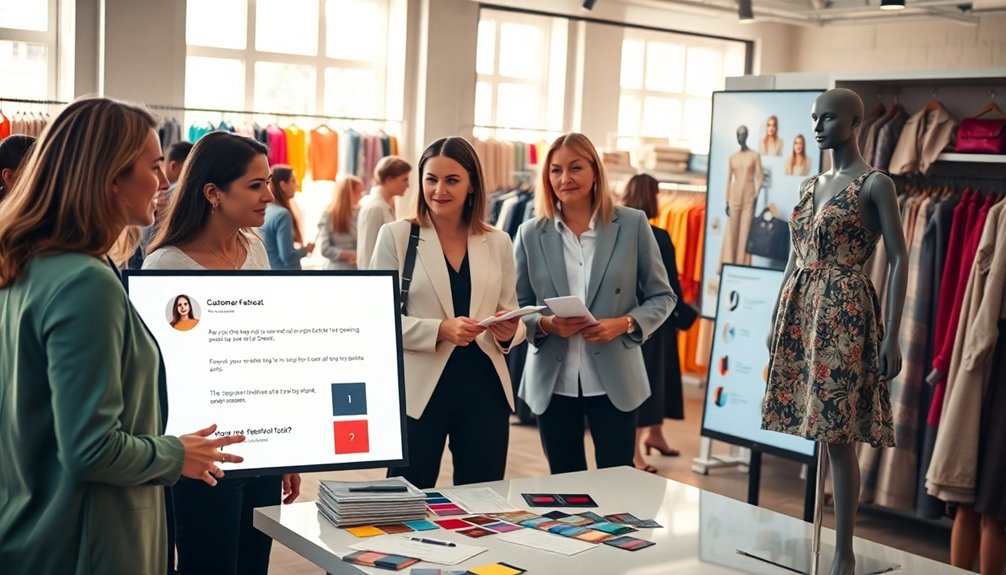
While maneuvering through the dynamic world of fashion, buyers must prioritize building relationships and engaging with customers to stay ahead of trends. Buyers often rely on these connections to shape their product selections and guarantee they resonate with the market.
Here are some key strategies:
- Gather feedback to understand evolving consumer tastes.
- Collaborate with marketing teams for cohesive promotional strategies.
- Analyze sales data to inform future buying decisions.
- Foster transparency in communication to build trust.
Engaging with customers isn't just about selling; it's about creating a dialogue. By nurturing these relationships, buyers can adapt to market demands and secure loyalty, ultimately driving sales and enhancing brand perception. Additionally, understanding personal debt forgiveness bills can help buyers make more informed financial decisions as they navigate their purchasing strategies.
Frequently Asked Questions
How Do Fashion Buyers Find New Products?
Fashion buyers find new products by diving into market trends and customer preferences. They analyze social media, attend trade shows, and consult fashion forecasting services to spot emerging styles.
By visiting showrooms, they assess collections directly from vendors, checking product quality and negotiating deals. They also compare current trends to past sales data, ensuring the selections resonate with their target audience and fit the boutique's brand identity.
Building strong supplier relationships is essential too.
What Exactly Does a Fashion Buyer Do?
Did you know that 70% of consumers look for new styles every season?
As a fashion buyer, you analyze market trends and customer preferences to select products that will resonate with shoppers. You attend trade shows, negotiate with suppliers, and collaborate with marketing teams to guarantee your store's offerings align with consumer demand.
What Fashion Career Involves Selecting and Purchasing What the Store Sells?
If you're interested in a fashion career that involves selecting and purchasing what a store sells, consider becoming a fashion buyer.
In this role, you analyze customer trends, evaluate collections, and negotiate with suppliers. You'll spend time researching market demands and attending trade shows to guarantee you choose the right products.
Strong analytical skills and creativity are essential, along with experience to navigate the competitive retail environment effectively.
What Are the Different Types of Buyers in Fashion?
In the vibrant world of fashion, you'll find various types of buyers, each with their unique flair.
Retail buyers focus on finding fresh merchandise for stores, while wholesale buyers negotiate bulk purchases.
Fashion buyers curate collections tailored to trends, and e-commerce buyers analyze online data to enhance inventories.
Specialty buyers hone in on niche markets, like luxury or sustainable fashion, ensuring their selections resonate with specific consumer desires.
Each plays an essential role in the industry!
Conclusion
In the world of fashion, buyers are like skilled chefs, blending ingredients to create the perfect dish. Just as a chef tastes and adjusts, you've seen buyers analyze trends and tweak selections to delight customers. With their fingers on the pulse of consumer desires, they're not just stocking shelves; they're crafting experiences. So next time you slip into a trendy outfit, remember the behind-the-scenes magic that brought it to life, making each choice as flavorful as your favorite meal.
